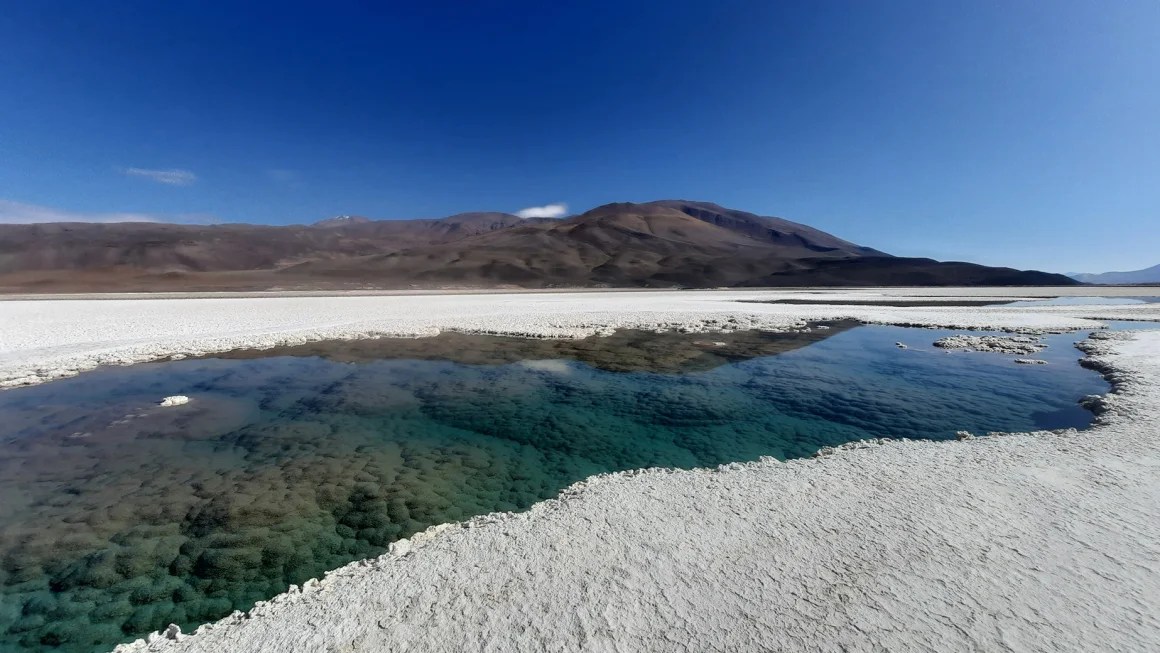(CNN)- Scientists have discovered a previously hidden ecosystem in the salt flats of the Buna de Atacama, an arid plateau in Argentina, with a system of expansive ponds. Stromatolites According to new research, goblins could provide a glimpse into early life on Earth and even on Mars.
Stromatolites are layered rocks formed by the growth of blue-green algae or cyanobacteria through photosynthesis. According to NASA, The structures are considered to be among the oldest ecosystems on Earth and represent at least the oldest fossil evidence of life on our planet. 3.5 billion years.
“These are certainly very similar to the earliest macrofossils on our planet, and are in a very rare environment on modern Earth,” he said. Brian Hynek, A professor in the Department of Geological Sciences at the University of Colorado Boulder, he helped document the ecosystem. “They are a window into the distant past of what life might have been like on our planet 3.5 billion years ago.”
Ancient giant stromatolites were widespread during Earth’s Precambrian period, covering the earliest period from about 4.6 billion to 541 million years ago, but are now sparsely distributed around the world. According to the non-profit conservation organization, the best-developed areas are in the Bahamas and Shark Bay, Western Australia. Bush Heritage Australia.
Modern stromatolites are relatively small, while ancient stromatolites typically grew to about 20 feet (6 meters) tall and 16 to 22 feet (5 to 7 meters) wide, Hynek said. Beneath the waters of the Buna de Atacama lagoons, newly discovered stromatolites are 15 feet (4.5 meters) wide and several feet high, according to a new publication. University of Colorado at Boulder.
The newly discovered giant stromatolites in Buna de Atacama are composed mainly of gypsum and rock salt. (Photo: Brian Hynek).
Stromatolites also tend to grow in alkaline conditions, but the lagoon system of the Buna de Atacama is acidic. Stromatolites found today are almost all carbonate rocks (made of limestone), but these structures are primarily composed of gypsum and halite (rock salt) minerals, Hynek said.
It’s not clear why stromatolites are so large, Hynek said, but he speculates that the internal ecosystem remained intact for a long time, allowing them to grow undisturbed.
More about EAncient stromatolites
Unlike modern stromatolites, ancient stromatolites grew in a time when there was no oxygen in the atmosphere. Under these conditions, microbes in stromatolites use it oxidative photosynthesis, Oxygen is not needed to convert light energy into compounds that support cells.
“It’s amazing to find biogenic (produced by living things) structures at this unusual height,” he said in an email. Peter Visscher, a professor of marine science at the University of Connecticut, has studied stromatolites extensively. “Biogenic or not, the main problem with the discovery is that these formed in the presence of oxygen (in the present atmosphere). There was no oxygen until 2.3 billion years ago.
Although stromatolites are found in oxygen-rich environments, HineEck said that the deeper layers of the rock have no access to oxygen and are actively formed by microorganisms using oxidative photosynthesis. It resembles structures found on ancient Earth.
The lagoon system in Argentina was initially discovered through satellite imagery in April 2022. (Photo: Brian Hynek).
Hynek discovered the pond structure through satellite images in April 2022 when he examined another pond in northwestern Argentina that contained tiny stromatolites with microorganisms that use oxidative photosynthesis.
“We don’t know if microbes are actively involved in their growth (in the newly discovered stromatolites). We believe they are. But we haven’t done experiments yet to find out in that area,” said Hynek, who documented the preliminary observations with microbiologist Maria Farias, co-founder of Bunapio SA Environmental Consulting. There’s work to be done. “We’ve found them, and we’ve barely scratched the surface.”
Hynek and Farías are scheduled to present their findings at this year’s Geophysical Union meeting in San Francisco on Dec. 11, according to a press release.
A possible window into ancient Mars
If stromatolites are produced by microbes through oxidative photosynthesis, the discovery could provide insight into the possibility of life on ancient Mars, Hynek said.
“We have identified MMore than 600 lakesOldest on Mars; There might even have been an ocean. So from the beginning it was like Earth,” he said. Hynek added Gypsum and halite mineralsFound in the stromatolites of Argentina, they are also found in salt deposits throughout Mars.
“If life ever developed on Mars through photosynthesis, it would be something like this We will search for (stromatolites), That’s the kind of thing we’re looking for,” says Hynek, a research associate at the Laboratory for Atmospheric and Space Physics at the University of Colorado at Boulder.
“If we’re going to find any kind of fossils on Mars, our best guess is what they’ll be because they’re the oldest in the Earth’s rock record.”
Hynek said he hopes to return to the lagoon soon to do more research on stromatolites.
“Stromatolites on Mars? A long shot, but who knows. So far there are no carbonates on the surface of Mars, but the search continues,” Visscher said, looking for possible signs of life.


:quality(85)/cloudfront-us-east-1.images.arcpublishing.com/infobae/733BC4GLSFHFXGV2W5HA6RSFF4.png)
:quality(85)/cloudfront-us-east-1.images.arcpublishing.com/infobae/YMJL5TYTFCDXREBK5GQ3GF2NSE.jpg)
:quality(85)/cloudfront-us-east-1.images.arcpublishing.com/infobae/6HQACP6IWFDCZILI6XO6YCAIT4.jpg)
:quality(85)/cloudfront-us-east-1.images.arcpublishing.com/infobae/MNC54VXNEZFZRNQPRR5NB7S774.jpg)